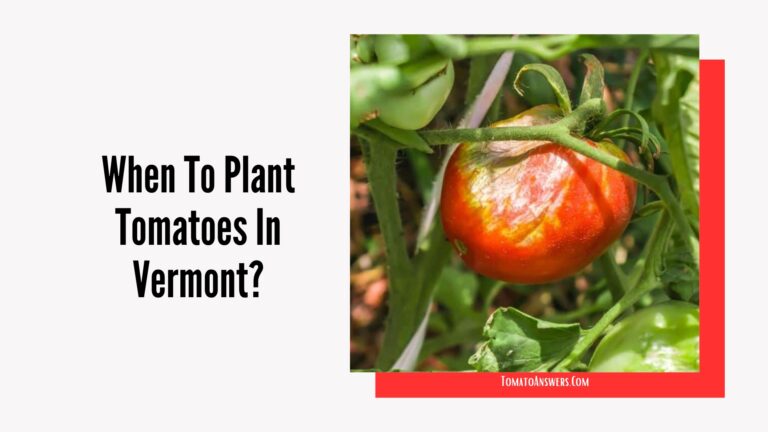In This Article
Key Takeaways:
- It’s best to wait until mid-May to early June to plant tomatoes in Vermont after the threat of frost has passed.
- Selecting tomato varieties well-suited for Vermont’s growing conditions, such as cold-hardy varieties, can increase the likelihood of a successful harvest.
- Proper soil preparation, watering, and fertilization techniques are essential to growing healthy, fruitful tomato plants in Vermont.
When To Plant Tomatoes In Vermont?
If you’re a tomato lover residing in Vermont, it’s crucial to understand the best time to plant tomatoes to ensure a bountiful harvest. Cultivating tomatoes requires careful planning and execution, considering Vermont’s specific growing conditions and climate.
This article explores the optimal time to plant tomatoes in Vermont, the planting season, and valuable tips for producing healthy, delicious tomatoes.
Tomato Planting Season in Vermont
When it comes to planting tomatoes in Vermont, timing is everything. The ideal month to plant tomatoes in Vermont is typically mid-May to early June after the last frost has passed. Planting too early can result in stunted growth or even death of the plants due to the cold weather.
When planning your tomato planting, it’s important to consider the tomato planting season in Vermont. The tomato planting season in Vermont typically lasts from May to September, with the peak season being from July to August.
Following a few key tips is important to ensure a successful tomato harvest in Vermont.
- Choose tomato varieties well-suited to Vermont’s cooler climate. Some recommended varieties include Early Girl, Celebrity, and Sweet Million.
- Additionally, prepare your soil properly before planting. Work in compost or other organic matter to improve soil fertility and drainage. You may also consider using plastic mulch or row covers to help regulate soil temperature and protect your plants from pests and disease.
- Tomato cultivation in Vermont is watering. Tomatoes need consistent moisture, particularly during their fruiting stage. To avoid overwatering, water deeply once or twice a week rather than frequent, shallow watering.
Tomato Planting Guide for Vermont
If you plan to grow tomatoes in Vermont, choosing the right varieties and planting them at the ideal time is important. Here’s a comprehensive tomato planting guide tailored specifically for Vermont’s growing conditions:
| Tomato Variety | Planting Schedule |
|---|---|
| Early Girl | Start seeds indoors 6-8 weeks before the last frost; transplant outdoors 1-2 weeks after the last frost. |
| Beefsteak | Start seeds indoors 6-8 weeks before the last frost; transplant outdoors 1-2 weeks after the last frost. |
| Roma | Start seeds indoors 6-8 weeks before the last frost; transplant outdoors 1-2 weeks after the last frost. |
Remember that the ideal planting time for tomatoes in Vermont is typically between late May and early June. You should also consider using raised beds or containers to help warm up the soil and provide better drainage for your tomato plants.
Enriching your soil with organic matter, such as compost or well-rotted manure, is a good idea to ensure that your tomato plants have the nutrients for healthy growth.
Tomatoes also require consistent moisture, so water them regularly and deeply to keep the soil evenly moist.
Finally, consider using organic pest control methods to protect your tomato plants from common pests, such as tomato hornworms and aphids.
Companion planting with herbs like basil, marigold, and parsley can also help to deter pests and improve the overall health of your tomato plants.
Tips for Growing Tomatoes in Vermont
Growing tomatoes in Vermont requires attention to detail, from soil preparation to watering and fertilization. Here are some helpful tips to ensure a successful harvest:
- Choose the right variety: Tomatoes come in different sizes, colors, and flavors. Make sure to choose a variety well-suited for Vermont’s climate and growing conditions. Some popular tomato varieties for Vermont include Early Girl, Champion, and Brandywine.
- Start with healthy tomato plants: Look for established, healthy plants with thick stems, deep green leaves, and no signs of disease or pests.
- Prepare the soil: Tomatoes thrive in well-draining soil rich in organic matter. Amend the soil with compost or aged manure before planting. Keep the soil moist but not waterlogged, as tomatoes prefer well-draining soil.
- Plant at the right time: Wait until after the last frost date (usually around mid-May) to plant tomatoes in Vermont. This will give the soil enough time to warm up and prevent damage to the young plants from frost.
- Provide support: Tomatoes are heavy plants that require support to prevent them from sprawling on the ground. Use stakes, cages, or trellises to support the growing plants.
- Water regularly: Tomatoes require consistent moisture to produce healthy fruit. Water deeply once a week or more often during hot, dry weather. Avoid getting water on the leaves, as wet leaves can promote fungal diseases.
- Fertilize regularly: Tomatoes are heavy feeders and require regular fertilization throughout the growing season. Use a balanced fertilizer formulated for tomatoes, and follow the package instructions for application rates.
- Prune selectively: Pruning can help improve air circulation and reduce disease risk. Remove any suckers (shoots that grow between the stem and a branch) and lower leaves that touch the ground.
- Watch for pests and diseases: Watch for common tomato pests like aphids, hornworms, and flea beetles. Also, watch for signs of fungal diseases like early blight and powdery mildew, and treat promptly with appropriate fungicides.
- Harvest at the right time: Tomatoes are ready for harvest when they’re fully ripe and have a deep, rich color. Gently twist the fruit from the stem to avoid damaging the plant.
Conclusion: When To Plant Tomatoes In Vermont?
Now that you know the optimal time and best practices for growing tomatoes in Vermont, you can confidently plan your garden. Plant your tomatoes in late May or early June after the last frost.
Choose the right tomato varieties, such as Early Girl or Celebrity, which are well-suited for Vermont’s growing conditions. Prepare your soil with organic matter and maintain consistent watering and fertilization.
With dedication and care, you can enjoy a delicious harvest of juicy, flavorful tomatoes that you can use in salads and sauces or enjoy fresh. Happy tomato growing!
FAQ about When To Plant Tomatoes In Vermont?
Q: When is the best time to plant tomatoes in Vermont?
A: The ideal time to plant tomatoes in Vermont is typically after the last frost date, usually around mid to late May. It is important to wait until the soil has warmed up and the risk of frost has passed. This ensures that the tomato plants have optimal growing conditions.
Q: What is the tomato planting season in Vermont?
A: The tomato planting season in Vermont usually begins in late spring and extends through the summer months. Considering the local climate and temperature patterns when determining the tomato planting season is important.
Q: What are some tips for successful tomato cultivation in Vermont?
A: To ensure successful tomato cultivation in Vermont, choosing tomato varieties well-suited for this region’s growing conditions is recommended.
Additionally, proper support for the tomato plants, regular watering, and adequate fertilization are essential for healthy growth and a bountiful harvest.
Q: What are the best tomato varieties for Vermont?
A: Some tomato varieties that perform well in Vermont include Early Girl, Brandywine, Sungold, and Celebrity. These varieties are adapted to cooler climates and have a shorter growing season, making them ideal for Vermont gardeners.
Q: Any additional tips for growing tomatoes in Vermont?
A: It is important to ensure that the tomato plants receive at least 6-8 hours of sunlight daily and are planted in well-drained soil. Mulching around the base of the plants can help conserve moisture and prevent weeds.
Regular pruning and monitoring for pests and diseases are crucial for maintaining healthy tomato plants.

